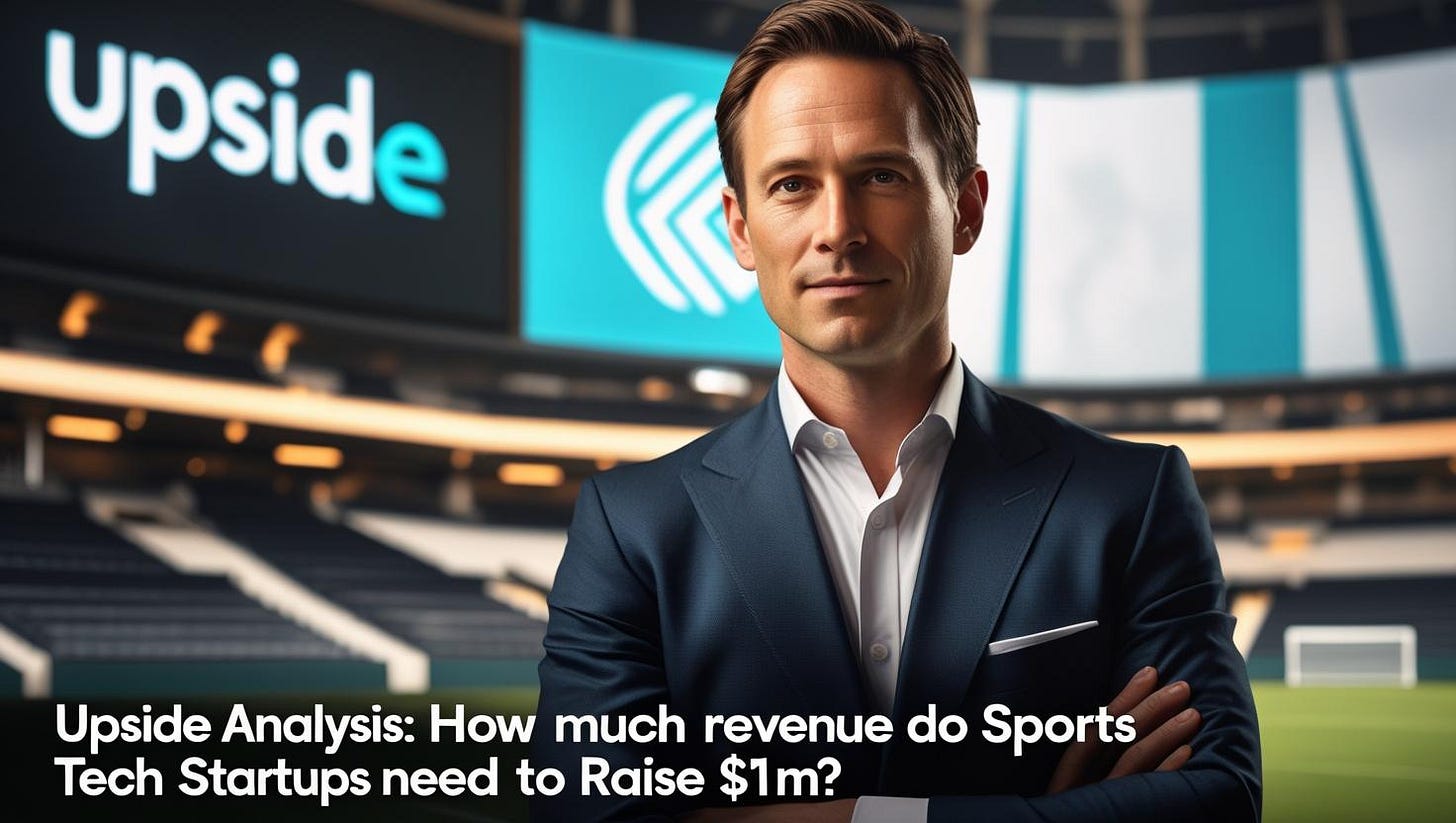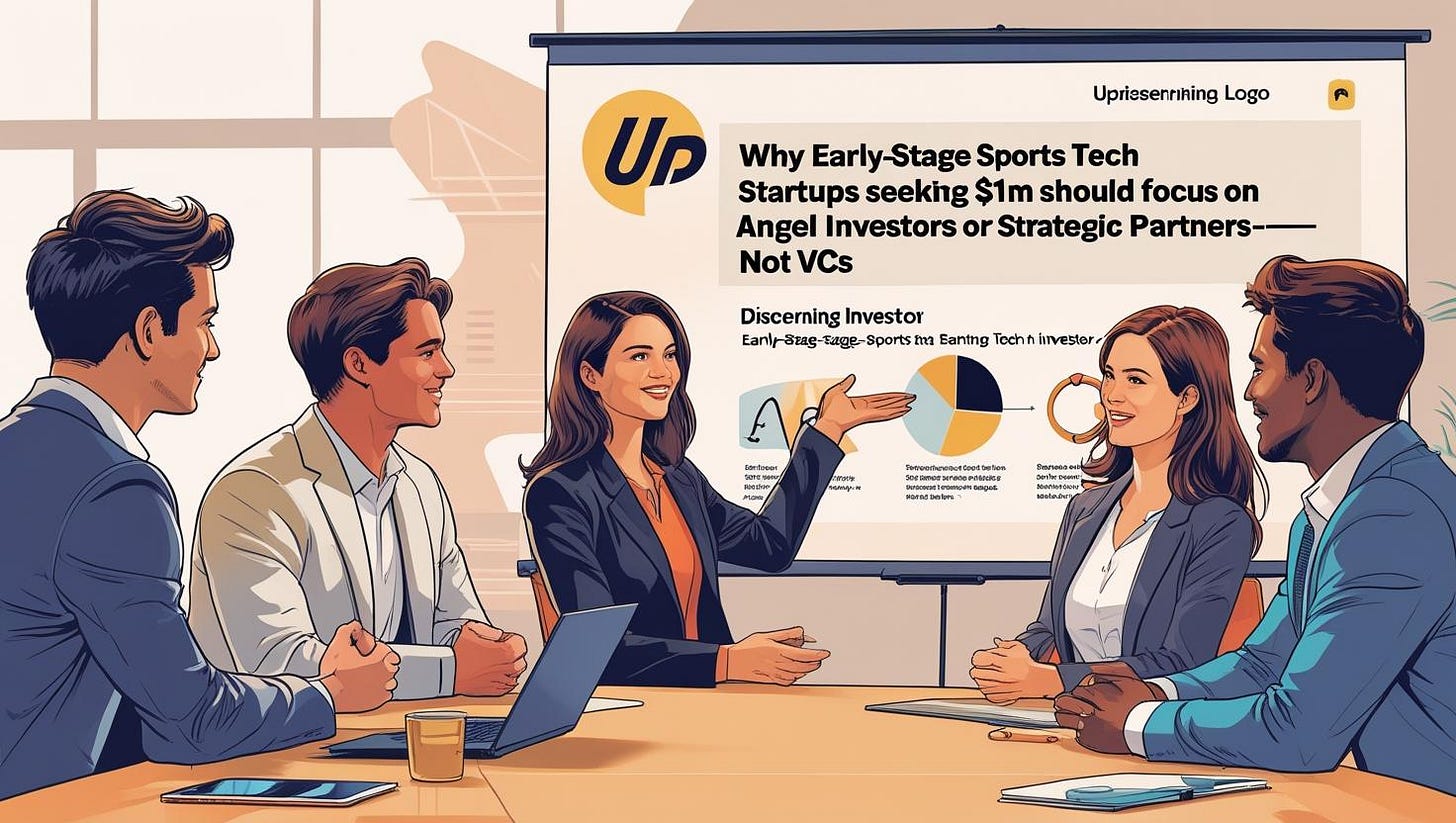💴 Upside Special Report: How Much Revenue Do Sports Tech Startups Need to Raise $1M? Why Startups Raising $1M Should focus on Angels or Strategic Partners, Not VCs.
Raising capital as a sports tech startup is exciting—but it’s also tough. One of the most common questions founders ask is: "How much revenue (ARR) do I need to raise a $1M seed or pre-seed round?" While there’s no one-size-fits-all answer, sports tech VCs typically look for a minimum Annual Recurring Revenue (ARR) of $200K–$500K when considering a $1M investment, depending on the business model and traction in the market.
Target ARR Range
Early pre-seed (with a prototype and pilots): $0–$100K ARR, often raised through angel investors or accelerators.
Seed stage (with paying customers and early traction): $200K–$500K ARR.
Late seed or Series A (scaling revenue): $750K+ ARR, ideally $1M+.
However, ARR is just one piece of the puzzle. In sports tech, investors often weigh a combination of quantitative and qualitative factors.
What Else Do Sports Tech VCs Look For?
1. Validated Use Cases
VCs want to see that your product solves a real, high-priority problem—preferably validated through pilot programs or contracts with pro teams, leagues, or college programs. Case studies with strong ROI metrics are gold.
2. Team Credibility
Founders with domain expertise (e.g., former athletes, team staff, or engineers with industry knowledge) have an edge. Teams that understand both the sport and tech sides are highly valuable.
3. Market Size & Scalability
Investors want to know that your solution can scale beyond a handful of elite teams. Can your product be applied to:
Youth and amateur sports?
Corporate wellness?
International markets?
The Total Addressable Market (TAM) needs to justify venture-level returns.
3. Repeatability and Retention
A few one-off deals won’t cut it. VCs look for recurring revenue models (SaaS preferred), high retention rates, and a clear path to expand accounts.
4. Strategic Moats
Do you have unique data, patents, or deep integrations that would make it hard for competitors to replicate your product? Are you embedded into a team’s workflow?
5. Bonus Points: Signals That Boost Fundraising Chances
Backing by a well-known accelerator (e.g., Techstars Sports, Stadia Ventures).
LOIs or verbal commitments from big-name leagues (NBA, EPL, NCAA).
Early partnerships with hardware, media, or performance training vendors.
Involvement of influential advisors or athlete investors.
Bottom Line
To raise $1M, sports tech startups should aim for $200K–$500K in ARR with signs of strong product-market fit, repeatable growth, and a compelling story. But that's in theory. Not everyone can generate $200k-$500k in ARR from the get go. ARR is important—but traction, team, and total opportunity matter just as much. If you're below that range but have high-caliber customers or intellectual property, pre-seed funding is still possible—especially if your vision is big and the team can execute.
In the fast-evolving world of sports tech, securing early funding is often the difference between a prototype that fades out and a product that scales. But if you're a startup founder aiming to raise around $1 million, here’s a hard truth: venture capital may not be your best first stop. Instead, you’re likely better off targeting angel investors or strategic partners.
🏦 Why VCs Might Not Bite Yet
Venture capital firms—especially institutional ones—are typically hunting for deals that check three boxes:
Big market (preferably $1B+)
Clear path to hyper-growth
An investable stage with proven traction
While the sports tech space is undeniably exciting, it’s also niche and relationship-driven. For most early-stage startups raising sub-$1M, the average check size VCs want to write (usually $2–5M+) doesn’t align with the risk profile and limited traction often seen at this phase. Unless you're generating $500K+ in ARR with double-digit monthly growth, many VCs will see your raise as “too early.”
Even worse, if you do manage to raise from a VC prematurely, they’ll often push for hypergrowth before you’ve nailed your product-market fit, which can lead to avoidable burn, missed execution, or long-term dilution.
👼Why Angels Make Sense
Angel investors, especially those with deep roots in sports, media, or health, are ideal early backers. Here’s why:
✅ They bet on people, not just metrics
✅ They understand sports is a trust-and-access game
✅ They’re often former athletes, execs, or operators who bring networks, not just capital
An angel investor who knows how teams evaluate tech, or who can open the door to your first league pilot, is far more valuable than a VC at this stage.
🤝 Why Strategic Partners Are Even Better
Some of the most successful early-stage sports tech startups didn’t raise from VCs first—they raised from strategic partners: leagues or even equipment brands.
Why This Works:
🧪 Built-in validation: A partner that uses your tech in the real world is worth 10x more than a LinkedIn testimonial.
🌍 Distribution channels: Your first real partnership might lead to your first 10 sales.
🔁 Tighter feedback loops: These relationships expose you to day-to-day usage and help fine-tune your product before you scale.
🧭 What to Do Instead of Chasing VCs
Build a short list of influential angels in sports & health. Former athletes, team execs are great starting points.
Identify 3–5 strategic entities—teams, leagues, academies, agencies—who would benefit from your tech. Think pilot > pitch.
Tell a compelling vision, not just a product story. Angels and partners want to back a mission they believe in.
✅ Final Thought
The first $1 million isn’t about blitzscaling—it’s about proving your solution actually works and creates value. VCs may become important in later rounds, but in the earliest stages, you need believers, insiders, and allies—not fund logos on a pitch deck. So forget the follower count. Find someone who knows the turf.
Best,
You may also like:



